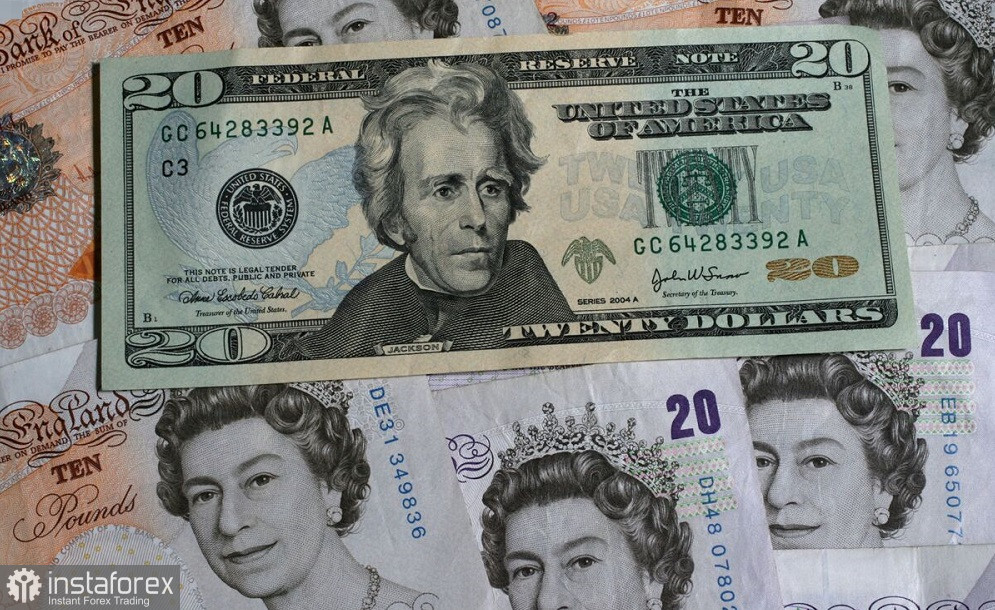The pound failed to break through the 1.36 level. The pair had been actively rising for the past two and a half weeks, but the 1.3600 target proved to be out of reach for buyers. Notably, the price was rising not only due to the overall weakening of the US currency but also thanks to the pound's own strengthening. Two days ago (August 12), relatively solid UK labor market data was released, and the GDP growth report came in "in the green." The dollar, meanwhile, had been weakening on the back of its own fundamental factors. ISM indices, labor market data, and the CPI growth report—all these releases had been unfavorable for the greenback. Only the PPI growth report "distorted" the fundamental picture, giving the US currency unexpected support.

Let's start with the UK releases. Briefly recalling, the UK labor market report was somewhat mixed. The unemployment rate remained at the previous month's level (4.7%), while average earnings (including bonuses) fell to 4.6%. The pound reacted positively to the report, as traders focused on its stronger aspects. For example, the number of jobless claims fell by 6,000 in July, whereas most analysts had forecast an increase of 20,000. Moreover, average earnings excluding bonuses returned to the 5% mark—the same as in the previous month. Assessing the release, most traders decided that the "glass is half full," meaning the report supported the Bank of England's wait-and-see stance at upcoming meetings.
The UK GDP growth report only reinforced the fundamental picture. It showed that in June, the British economy grew by 0.4% month-on-month (after a 0.1% contraction in May) and by 0.3% quarter-on-quarter. Both figures came in "in the green," whereas forecasts had been for 0.2% m/m and 0.1% q/q. Industrial production in June rose by 0.7% m/m (after a 1.3% decline) and by 0.2% y/y (after a 0.2% drop). Manufacturing output increased by 0.5% m/m and showed zero annual growth (while most analysts had forecast a 0.9% decline).
However, GBP/USD traders were primarily interested in the second-quarter data, as the BoE focuses mainly on quarterly results. Here, too, the British economy did not disappoint. GDP grew by 1.2% y/y, compared with expectations for a more modest 1.0% rise. On a quarterly basis, the figure rose by 0.3% (versus the 0.1% forecast).
The report's breakdown shows that June's strong result offset GDP declines in May (-0.1%) and April (-0.3%). The services sector was the key driver of economic growth (7 of 14 subsectors expanded). Service industries accounted for nearly all net GDP growth, effectively keeping the country from stagnation or recession. Particularly strong gains were seen in the information and communications sector (+2.0%, with IT up 4.1%), healthcare (+1.1%), and administrative/support services.
Overall, the report significantly reduced the likelihood of the BoE opting for another rate cut at one of its upcoming meetings in September or November.
This allowed GBP/USD buyers to approach the 1.36 level. However, the US PPI growth report turned the pair south, as the release favored the greenback.
The overall Producer Price Index jumped to 3.3% y/y, while most analysts had expected a much more modest increase to 2.5%. This was the strongest growth rate since March this year. Core PPI also rose sharply—to 3.7%—after five consecutive months of declines (June's figure was 2.6%). Several factors drove this sharp surge. First, margins: according to the Bureau of Labor Statistics (BLS), more than 40% of the monthly PPI growth was due to higher trade markups. Second, tariffs: new duties on Chinese and other foreign goods are starting to affect production costs, especially in manufacturing. This has led to higher prices for intermediate goods and components.
Following the PPI release, the probability of no policy change at the September meeting rose to 10% (according to CME FedWatch), whereas before the release, this scenario was not considered at all (there had even been a 5% probability of a 50-basis-point rate cut in September).
Given such an unexpectedly strong PPI report, it is best not to rush into GBP/USD longs, as the dollar is likely to keep pricing in this release in the near term. Long positions should only be considered once the pair moves back above the Tenkan-sen line on the H4 timeframe, i.e., above 1.3550. This would indicate that the downside momentum has faded and that buyers have regained control of the pair (in addition, in this case, the Ichimoku indicator would once again form a bullish "Parade of Lines" signal). The upside target remains 1.3620 (the upper Bollinger Bands line on the same timeframe).





















